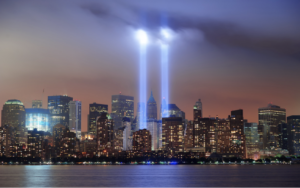


This time period extends from 1980 to the present and counts for 5% of recommended instructional content for an AP class. It does not appear on the DBQ.
KEY CONCEPT 9.1
A newly ascendant conservative movement achieved several political and policy goals during the 1980s and continued to strongly influence public discourse in the following decades.
KEY CONCEPT 9.2
Moving into the 21st century, the nation experienced significant technological, economical, and demographic changes.
KEY CONCEPT 9.3
The end of the Cold War and new challenges to U.S. leadership forced the nation to redefine its foreign policy and role in the world.
OVERVIEW
AP U.S. History Period 9 covers from 1980 to the present. It focuses on the rise of the conservative movement beginning in the 1980s, technological and economic changes, and the end of the Cold War.
The conservative movement from the 1980s to the present traces its origins to the election of Ronald Reagan in 1980. The Reagan administration enacted significant tax cuts and deregulated many industries. Conservatism at the federal level inspired similar efforts at local and state governments. Governments at all levels began to reduce funding for social programs and limit the scope of government authority.
At the same time that the Reagan administration was reducing domestic spending, it was pursuing an interventionist foreign policy. U.S. military spending increased in the late 1980s and has continued to increase up to the modern-day, as the United States continues to assert a role in foreign affairs. Following the terrorist attacks of September 11, 2001, most U.S. foreign policy has focused on fighting terrorism around the world.
“There is one sign the Soviets can make that would be unmistakable, that would advance dramatically the cause of freedom and peace. General Secretary Gorbachev, if you seek peace, if you seek prosperity for the Soviet Union and Eastern Europe, if you seek liberalization: Come here to this gate! Mr. Gorbachev, open this gate! Mr. Gorbachev, tear down this wall!”
—President Ronald Reagan, 1987

Beams of light shine from the site of the former World Trade Center towers in lower Manhattan, New York City, memorializing the victims of the terrorist attacks of September 11, 2001.
TIMELINE
1981 IBM releases the first personal computer.
1983 President Reagan announces the first Strategic Defense Initiative.
1989 The Berlin Wall is torn down, symbolizing the end of the Cold War.
1991 The World Wide Web goes public.
1991 The Soviet Union collapses after Mikhail Gorbachev resigns.
1998 President Bill Clinton impeached by the U.S. House of Representatives.
2001 Terrorists execute a series of attacks on the World Trade Center in New York, the Pentagon, and Shanksville, Pennsylvania.
2003 The United States invades Iraq.
2011 The last U.S. troops leave Iraq.
KEY TERMS
Cold War A period of diplomatic tension between the United States and the Soviet Union that pitted capitalism against communism.
Ronald Reagan The Reagan administration reduced government spending, extended tax cuts, and cut many welfare and social spending programs.
Terrorist attacks of September 11, 2001 A coordinated series of terrorist attacks that remain the deadliest terrorist attacks on U.S. soil. These attacks led to wide-ranging changes in almost all aspects of American life.
The best way to get better at something is by practicing.
That’s why it’s so important that you take practice tests to help you get better at the AP U.S. History Exam. Only then can you expect to get a good score—and even improve your score.
Download your free AP® U.S History practice test HERE.
Download your printable study guides for all of the units for AP U.S. History HERE.
 Help
Help